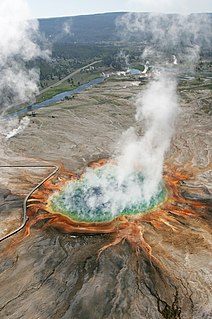
Thermus is a genus of thermophilic bacteria. It is one of several bacteria belonging to the Deinococcus–Thermus group. It includes the following species:
Thiomonas islandica is a Gram-negative, rod-shaped, motile bacterium from the genus Thiomonas, which has the ability to oxidise sulfur compounds and hydrogen. It was isolated from a hot spring in Graendalur in southwestern Iceland.
Verrucosispora sediminis is a bacterium from the genus of Verrucosispora which has been isolated from deep sea sediments from the South China Sea.
Laceyella tengchongensis is a thermophilic bacterium from the genus of Laceyella which has been isolated from soil from the Big Empty Volcano in Tengchong in China.
Laceyella sacchari is a bacterium from the genus of Laceyella which has been isolated from a bagasse in Thailand.
Planifilum yunnanense is a thermophilic bacterium from the genus of Planifilum which has been isolated from a hot spring in Yunnan in China.
Porphyrobacter tepidarius is a moderately thermophilic and non-motile bacteria from the genus of Porphyrobacter which has been isolated from a hot spring in Usami in Japan.
Thermonema lapsum is a Gram-negative and thermophilic bacterium from the genus of Thermonema which has been isolated from a hot spring in Rotorua in New Zealand.Homospermidine and homospermine are the major polyamines of Thermonema lapsum
Microbacterium sediminis is a Gram-positive, rod-shaped, aerobic, psychrotolerant, thermotolerant, halotolerant, alkalitolerant bacterium from the genus of Microbacterium which has been isolated from deep-sea sediments from the Indian Ocean.
Prauserella flava is a bacterium from the genus of Prauserella which has been isolated from the Aiding Lake in China.
Prauserella salsuginis is a bacterium from the genus of Prauserella which has been isolated from the Aiding Lake in Xinjiang in China.
Prauserella sediminis is a bacterium from the genus of Prauserella which has been isolated from the Aiding Lake in Xinjiang in China.
Brockia lithotrophica is a thermophilic bacterium from the genus of Brockia which has been isolated from a sediment-water mixture from a hot spring in Uzon Caldera in Russia. This bacterium is rod shaped, spore-forming and obligate anaerobe. It is lithoautotroph and grows on a mineral medium with molecular sulfur, thiosulfate or polysulfide; it has optimal growth temperature in the range of 60-65 °C for pH 6.5, but it is able to grow between 46°C and 78 °C and pH ranging from 5.5 to 8.5.
Pseudonocardia sediminis is a Gram-positive and aerobic bacterium from the genus of Pseudonocardia which has been isolated from marine sediments from the South China Sea.
Caldanaerobacter uzonensis is a thermophilic, anaerobic and heterotrophic bacterium from the genus of Caldanaerobacter which has been isolated from a hot spring in Uzon Caldera in Russia.
Caldanaerobius fijiensis is a thermophilic, obligately anaerobic and spore-forming bacterium from the genus of Caldanaerobius which has been isolated from a hot spring in Fiji.
Carboxydothermus islandicus is a thermophilic and anaerobic bacterium from the genus of Carboxydothermus which has been isolated from a hot spring on Iceland.
Caldalkalibacillus uzonensis is a thermophilic, alkalitolerant, aerobic, heterotrophic spore-forming bacterium from the genus of Caldalkalibacillus which has been isolated from the hot spring Zarvarzin II from the East Thermal Field in Uzon Caldera in Russia.
Calditerrivibrio is a genus of bacteria from the family of Deferribacteraceae with one known species. Calditerrivibrio nitroreducens has been isolated from a hot spring from Yumata in Japan.


